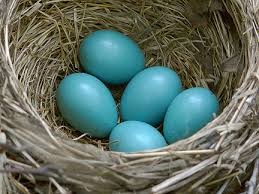People have always wondered why many birds lay bright blue eggs.
David Lahti York and Dan Ardia tested the hypothesis that pigmentation might help an egg strike a balance between two opposing and potentially damaging effects of the sun: light transmission into light-colored eggs, and heating up of dark-colored eggs.
As predicted, more intensely blue eggshells shielded the interior from light, including dangerous UV radiation–but more intense color also caused eggs to absorb more light and heat up, which can be even more dangerous in brighter environments.
These two patterns–termed by the authors “pigment as parasol” and the “dark car effect”–combined with knowledge of the nesting behavior and habitats of birds, can lead to predictions as to why the eggs of some birds vary across species from blue to white.
Darker eggs are predicted in moderate light to shield the embryo, but in brighter nests the dangers of egg heating predict lighter colored eggs. Whereas camouflage from predators is still probably the single most important factor governing the evolution of dull and mottled egg colors, for the brighter colors the biophysical evidence points to the sun.
Source: Science daily
N.H.Kh

